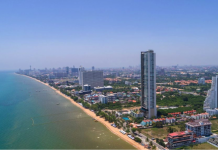U-Tapao set to become a full-scale commercial airport
Plans for turning the navy-controlled U-Tapao airport into a fully-fledged international gateway have been mooted for many years, but recent reports suggest the upgrading of the facility is now well and truly a definite for Thailand.
On 2 June this year the Royal Thai Navy and the Ministry of Transport signed a memorandum of understanding (MoU) charting a three-phase development of U-Tapao airport that will reach beyond 2020 and raise the capacity of its air traffic five-fold. Even so, the airfield will remain as a dual-usage facility, for both commercial and military air traffic.
U-Tapao has operated as a semi-commercial airport since 1976 after being built as a military airfield and greatly expanded by the Americans during the period of the Second Indochina War, more popularly known as the Vietnam War.
The discount airline Air Asia has already signed on to help turn U-Tapao into a new hub for regional flights. An Air Asia flight from Kuala Lumpur in July marked the beginning of a new surge in traffic to U-Tapao on a scale that has not been witnessed since the peak years of the Vietnam War.
Air Asia is the first budget carrier to start scheduled services into and out of U-Tapao, with four flights a week, utilizing the 180-seat Airbus 320 plane. This marks a change to the previous use of U-Tapao which mainly has taken charter services from Russia and China with the focus on bringing in tourists to Pattaya.
Air Asia’s sister airline Thai Air Asia (TAA) has announced it plans to make U-Tapao its headquarters and will have a series of scheduled flights into Thai provinces as well as into a few Chinese cities.
TAA officials said they expect to be able to announce the planned schedule of flights in August and will begin actual services in October this year. Two of TAA’s A320 aircraft will be based at U-Tapao.
According to reports, these plans should see a surge in passenger traffic to around 600,000 in 2016 from flights by Thai and Malaysian Air Asia carriers. By comparison, U-Tapao saw 120,000 passengers in 2014, which amounts to just 10 percent of the airport’s handling capacity. So, even a jump to 600,000 passengers will not stretch the airports’ abilities.
Bangkok Airways already operates scheduled flights to Koh Samui and Phuket, but these are on ATR 72 propeller aircraft.
Air Asia management said it had carefully considered the options for using U-Tapao and is confident the airport, which is just 45 kilometres from Pattaya, will prove to be a profitable addition to its overall services.
For its part, those in charge of U-Tapao are keen to attract airlines and are currently offering a 25 percent discount on landing fees as well as potentially lower fuel charges by way of a deal with PTT Plc.
Talks are taking place with Bangkok Airways to increase the number of its flights out of the airport while another commuter airline, Kan Airways, is expected to resume flights soon.
In terms of passenger-designed infrastructure, a second terminal is due to be completed by either February or March 2016, at a cost of around 700 million baht. Once fully operational, it will raise U-Tapao’s capacity to around three million passengers a year.
By around 2020 it is planned that further extensions and improvements will raise passenger capacity to around five million people per annum.










